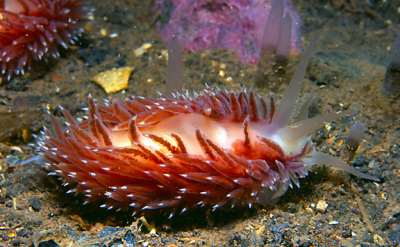Flabellina species from Maine, USA
December 31, 2004
From: Alan D. Shepard


Bill -
It's wonderful to have the Sea Slug Forum up and running again. I have a number of photos to send you of a few different species but I'd like to start with one that I was very excited to find this past summer in Eastport, Maine.
I first observed this species on July 18, 2004 in approximately 15 metres of water. The substrate was sandy and populated by a solitary hydroid species, Corymorpha pendula. The initial specimen was not particularly large, maybe 25 mm or so. I knew it was not one of the more common Flabellina species I encounter in the area but was not sure what it was. I could find no photos that matched it in any texts or on the Internet. I did however recall a mention of a deepwater Coryphella species mentioned in Bleakney's book, Sea Slugs of Atlantic Canada and the Gulf of Maine (page 125.) Bleakney maintains the usage of Coryphella rather than Flabellina in his book.
The passage states that the species is found below 20 metres (that can be adjusted now as I've found it in water as shallow as 12 metres) that it is found in sandy areas and that it feeds upon Corymorpha pendula. It is recognized in Dr. Alan Kuzirian's thesis paper of 1979.
I observed more and more of this species over a period of approximately one month. Observing the last one on August 15, 2004. I dove numerous times after that and did not encounter any specimens. I always found the species in the sand usually mating, laying eggs or feeding on the hydroids. As time went on the specimens I encountered seemed to be larger and larger. At the end of the period of observation large individuals were usually about 65mm or so. Water temperature over the period ranged from 8c to 8.5c.
I contacted both Dr. Kuzirian of the Marine Biology Laboratory in Woods Hole, Massachusetts and Dr. Larry Harris of the University of New Hampshire and sent them some photos of the species. Both confirmed that this was the species mentioned in Dr. Kuzirian's 1979 paper. Dr. Harris was Dr. Kuzirian's advisor. Dr. Kuzirian indicated that the species remains unnamed at this time as he has had no time to get a full description necessary to get an official name. He has a name in mind but prefers not to use it until it can become official. He also mentioned that it was first reported in 1872.
Dr. Harris commented on the remarkable metabolism of the species. He stated that at low temperatures it has an extremely high metabolism and seemingly grows before your eyes. After observing this species for a month I'd have to concur with that. There seemed to be two slight color variations of the species. Some had lighter orangey-red cerata while others had deeper wine-red cerata.
I am sending you a number of photos of the species in three separate messages. The photos include feeding behavior [message #12856], and mating & egg laying [message #12857 ]. They also show the hydroid prey species.
Locality: Eastport, Maine, USA. Atlantic Ocean
Depth: 12 to 25 metres, Length: 60 mm, 18 July 2004
Sandy substrate, extreme tides, strong currents
Photographer: Alan Shepard
Again glad to have the Forum up and running.
Best wishes,
Alan Shepard
Tolland, CT, USA
alan.chepard@snet.net
Shepard, A.D., 2004 (Dec 31) Flabellina species from Maine, USA. [Message in] Sea Slug Forum. Australian Museum, Sydney. Available from http://www.seaslugforum.net/find/12855Dear Alan,
This is a very nice welcome-back present for the Forum. I remember this unnamed species that Alan Kuzirian discussed in his excellent 1979 paper on Flabellina ecology. He stated that as well as being found only in deeper water and feeding on Corymorpha pendula, it showed remarkably rapid growth rates, had multiple eggs per capsule, and at least 2 generations per year. I have never seen a photo of it before, so your excellent series of photos are very welcome.
-
Kuzirian, A.M. (1979) Taxonomy and biology of four New England coryphellid nudibranchs. Journal of Molluscan Studies, 45: 239-261.
Best wishes,
Bill Rudman
Related messages
-
Flabellina from Maine - feeding
From: Alan D. Shepard, December 31, 2004 -
Flabellina from Maine - mating behaviour
From: Alan D. Shepard, December 31, 2004
